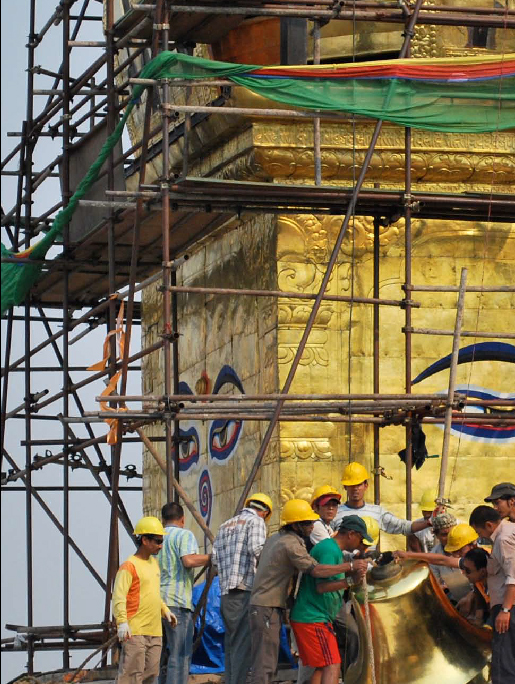Learning From the Valley
Tsering Palmo Gellek
The Svayambhu Stupa (the name means “Self-Arisen”) rests on a small hill near the center of the Kathmandu Valley in Nepal; visitors must climb 365 steps to reach its base. It is said to have appeared first as a miraculous stupa of light, arising on a lotus in the vast sea that covered the Kathmandu Valley. The Bodhisattva Manjushri drained the lake with a stroke of his wisdomsword, giving access to the Stupa. Much later its sacred form was encased in rock. Historical records trace it back more than 1,500 years, and for the past eight centuries, lamas from Tibet have frequently taken responsibility for restoring the Stupa. The previous restoration, carried out by the famed yogin Togden Shakya Shri, was completed in 1918.
In 2008, Tarthang Rinpoche initiated the fifteenth restoration of the Stupa. He asked his youngest daughter, Tsering Gellek, to take responsibility for the restoration.
Working with Padma Maitland, a young architect also raised in the Nyingma community, and Karen Monesi, a member of Nyingma Centers in São Paulo, she took responsibility for supervising a team of seventy Nepali artisans, many of whom came from families that had worked on previous restorations. Dozens of local groups took an active interest in the restoration work, leading to many complicated negotiations. Here Tsering reflects on the lessons she learned from the challenges of this remarkable project, which came to a successful conclusion in 2010. A video documentary about the project, Light of the Valley, has been widely shown in America and around the world, and a book by the same title was published by Dharma Publishing in 2011.This article is adapted from the front matter of the book.


During the Svayambhu Renovation project, people sometimes asked me about my qualifications to lead this project. Western tourists visiting the site thought I must be an archaeologist, an artist, an architect, or at least a contractor. Since I was none of these, I would respond that I was a man- ager or a facilitator. None of the Nepalis or Tibetans who visited Svayambhunath ever once questioned why I would be in charge of the renovation. I presume this is because my father as a respected Tibetan lama and the patron had carved out a certain role for me to carry out Dharma work. Nevertheless, I am not a lama and have no special spiritual qualifications or attainments like the illustrious renovators of the past. Being neither a professional renovator nor a lama, I was simply not very qualified to be in charge of such an important work.
I would like to offer the sympathetic reader a few simple lessons that came from my direct experiences as director, with the hope that they may make it a little easier for you to travel any path in your own life.
During the renovation, while navigating some of the narrowest passages, and at times when I felt particularly alone, learned and kind people told me that it is important to turn inward and discover the riches of one’s own mind. I found it equally important to expand upwards and out- wards to accommodate the hardships of others. I discovered that I must learn to be- come both my own best friend and the friend of all experiences good and bad, including the painful difficulties of others.
I learned that when it doesn’t seem that things can get worse, they can. It is said in the teachings that the more meritorious the project, the more obstacles appear. Thus, one must learn to accept that there are no rules about how much any person can suffer. Because the heart can bear so much, it is better to let go as much as possible of any boundaries between yourself and others. Recognizing this in- credible tendency to experience pain helps you open to all beings and keeps you focused on your higher purpose. And since no outside saviors or magical interventions may appear, even in a very special Dharma project, one must learn to deal with the transformation of mundane thoughts into an understanding that is at least neutral, and hopefully kind. Making the effort to overcome obstacles in itself makes way for blessings to manifest.
The conclusion of any project is generally anticlimactic. One should not expect recognition, and least of all great appreciation. I was told by a nun that when you find your guru, you have hired an assassin for your ego, and when you take on humanitarian work, you’ve hired a hundred! Confusion and arguments arise in every project, but if you let go of ‘wrong’ and ‘right’, you can at least imitate the qualities of patience and endurance.
Parties and social events, as much as pujas and ceremonies, are ways of helping people feel good and happy, and when people are happy, working together is much more enjoyable. Small numbers of really motivated people are capable of doing nearly anything.
It seems unusual to give thanks to a country, but I find myself owing thanks to Nepal for granting me the opportunity to serve her. Many people who visit Nepal remark on the inexplicable feeling of coming home. The soft green mustard fields set again lofty snow-capped peaks, gentle breezes, cozy miniature wooden and brick houses, golden temples enclosed in courtyards filled with wafting incense and adorned with flowers—all transport the visitor to one of the most heavenly places on earth. Here where the tectonic plates of the sub-continent forged the highest peaks of the world, the inner world of the indestructible diamond path was also made manifest. All Buddhas— past, present, and future—are born in Nepal. Until each and every one of us becomes a Buddha may the Self-Arisen Stupa continue to shine its light upon us all.
Tsering Gellek is currently director of the Sarnath International Nyingma Institute.